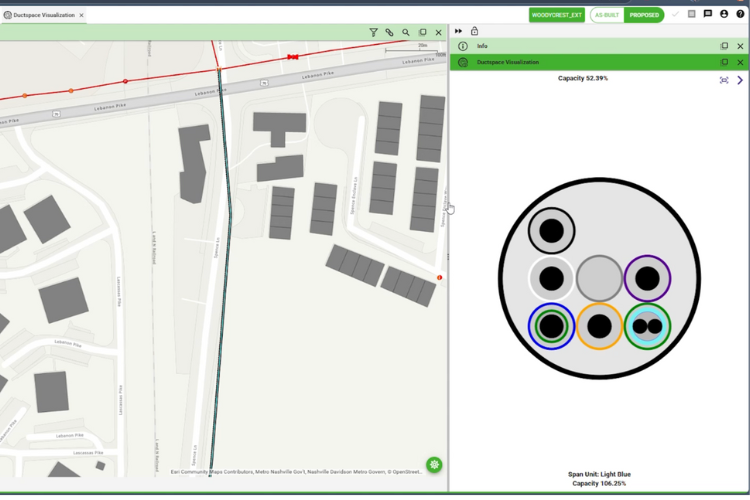A few years back, the telecommunications industry experienced a major shift. Network operators moved away from disconnected processes and basic tracking toward dedicated management platforms. But now that we have experience with these systems, a critical question emerges: Are we actually using them to their full potential?
Many organizations find themselves stuck with clunky management systems that, while "updated," still operate more like digital filing cabinets than true intelligence platforms. The next phase of fiber management goes beyond simply having a system. It focuses on using advanced mapping and spatial intelligence to transform network understanding, planning, and optimization.
A reality check: Management systems vs. intelligence platforms
Most fiber management systems can track assets and generate reports. But there's a significant difference between managing data and extracting intelligence from it. Isolated systems often create new silos—they organize information but don't reveal the relationships that drive strategic decisions.
Consider this: Your current system might tell you that fiber utilization is at 70% across your network. But can it help you understand the relationship between customer demand, existing infrastructure, and expansion opportunities?
This is one of the ways advanced mapping capabilities transform management systems from data repositories into business intelligence platforms.
From data to action: How fiber management systems create actionable insights
System integration
Several organizations still struggle with data scattered across departments—customer information in CRM systems, network assets in inventory databases, maintenance records in work order systems. Fiber management systems shouldn’t just collect this data; they should connect it, revealing patterns invisible in traditional reports.
Once integrated spatially, this data transforms from abstract metrics into visual intelligence. Network bottlenecks become obvious. Service gaps stand out clearly. High-value customer clusters emerge. Revenue opportunities that were buried in reports suddenly become visible on the map.
A leading dark fiber provider discovered this when they consolidated data from two separate systems. Their previous platforms tracked assets but couldn't show the full relationship between infrastructure, customers, and service opportunities, as the data was siloed. By implementing a single system of record, they were able to gain greater visibility into their network.
Analysis
A fiber management system should go beyond data display, offering deep insight into geography, demographics, and other critical spatial factors. How does terrain affect deployment costs? Where do service issues cluster geographically?
This sophisticated approach is driving significant market growth. The GIS in telecom sector is projected to expand from $2.16 billion in 2024 to $4.52 billion by 2030, reflecting the industry's recognition that spatial intelligence is becoming essential.1
Enhanced decision-making support
When stakeholders can visualize their network within its geographic context, strategic planning improves dramatically. Complex infrastructure decisions become clearer. Investment priorities align with spatial realities. Teams develop shared understanding based on visual intelligence.
Real-world impact: Intelligence in action
A major U.S. utility provider needed to expand their fiber network by 3,500 miles in six years. Their existing management system tracked assets but couldn't support strategic expansion planning. Their solution was a platform that provided:
- Automated network planning capabilities
- Detailed troubleshooting and utilization reporting
- Field mobility with integrated mobile applications
- Customer insights including related assets
The result: A successful migration of more than 10,000 records, along with seamless integration of mobile field operations, customer insights (including related assets and contacts), and CAD and CRM data—laying the foundation for strategic growth.
Transforming businesses
Organizations utilizing spatial intelligence are experiencing significant returns on investment. According to Technavio's research, market growth is being driven by:
- Enhanced capacity planning using spatial analysis
- Enterprise-wide geographic intelligence
- Improved customer service through location awareness
Telecom companies worldwide are implementing advanced mapping solutions to improve competitive positioning and operational efficiency.2
Beyond traditional applications
The progression beyond basic management is being further driven by the implementation of:
1. Digital twins: Virtual replicas of physical networks enable simulation and testing before deployment. Advanced systems can incorporate multiple data layers, creating comprehensive digital representations of network environments.
2. Augmented reality: Field technicians can access underground infrastructure data and network information overlaid on their physical environment, dramatically improving maintenance efficiency and decision-making.
The path to success
Knowing where to build, who to target, and how to maintain service quality often determines success or failure in the telecom industry, but many organizations haven't fully realized the potential of their platforms. Success now depends on transforming these systems from simple tracking tools into sophisticated intelligence platforms.
Whether you're planning a network expansion, optimizing existing infrastructure, or targeting new market opportunities, spatial intelligence provides the insights needed for strategic advantage.
The question isn't whether your organization has a management system—it's whether that system provides the advanced mapping and spatial intelligence capabilities needed to compete effectively in 2025 and beyond.
Citations:
1 P&S Intelligence. “GIS in Telecom Market Report.” 2024. https://www.psmarketresearch.com/market-analysis/gis-in-telecom-market
2 Technavio. “GIS Market Size in Telecom Sector to Increase by USD 1,417.93 million.” December 2022. https://www.prnewswire.com/news-releases/gis-market-size-in-telecom-sector-to-increase-by-usd-1-417-93-million-30-growth-to-originate-from-apac---technavio-301698490.html




